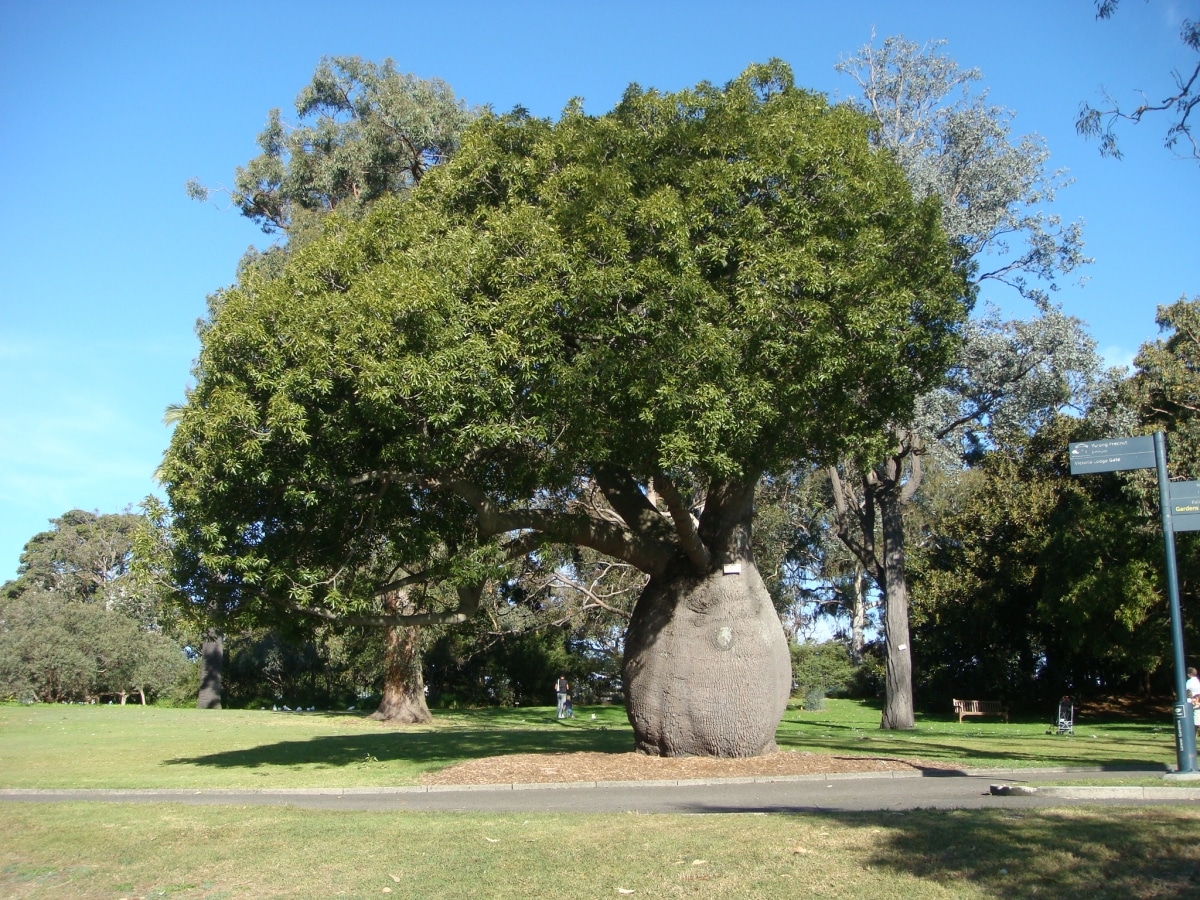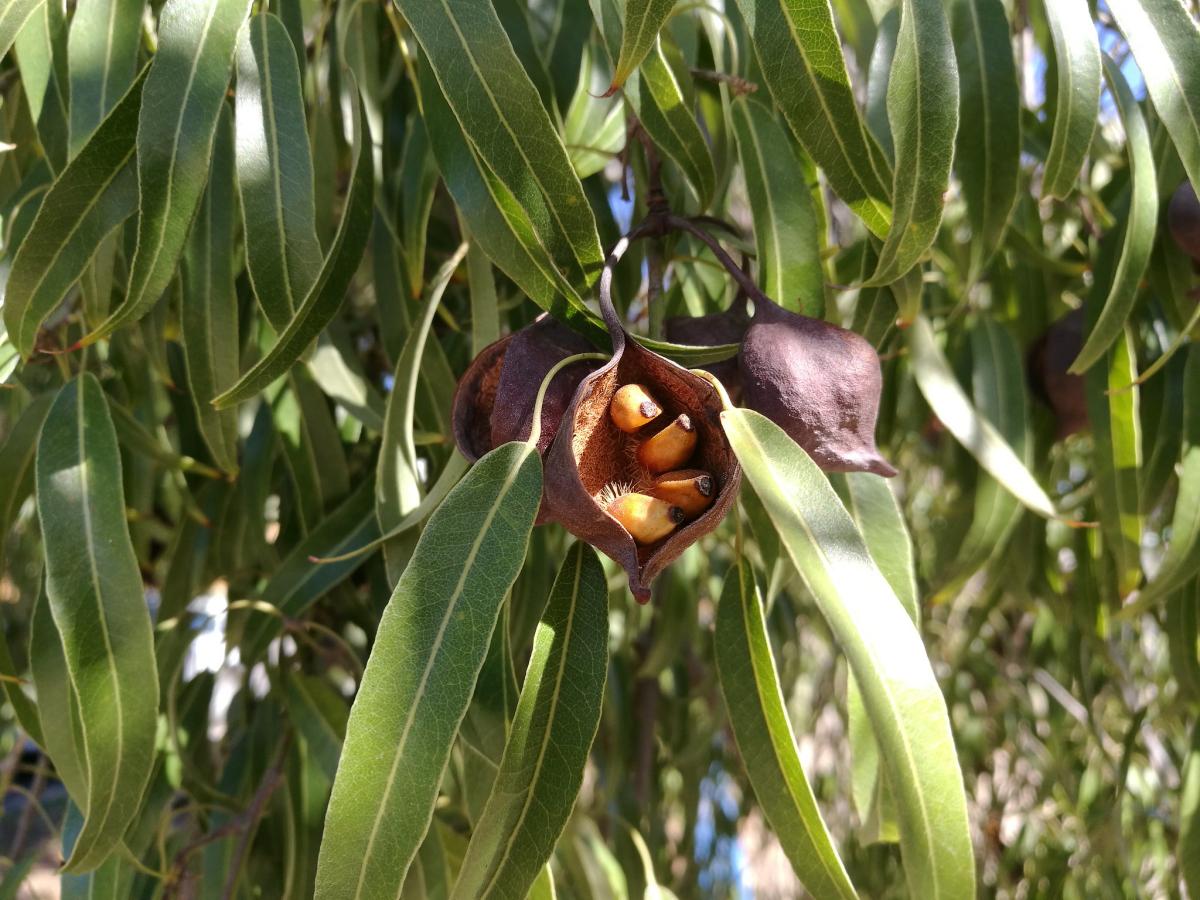
Image/Louisa Billet
El Brachychiton rupestris It is a tree of Australian origin that develops a thick trunk that acquires the shape of a bottle over the years. In addition, its flowers, although they are small, have a certain ornamental value, but you should know that it takes a long time to bloom for the first time.
And it is that its growth is not as fast as that of other trees. In general, and assuming that the conditions of the place are suitable for him, we can see that his height is about 15 to 30 centimeters higher each year. But yes, it is very resistant to drought and withstands the cold, two qualities to take into account if you want to have it in a place where the climate is temperate.
How is he Brachychiton rupestris?

Image - Flickr / David Stanley
It is a plant that grows in Queensland, Australia, whose scientific name is Brachychiton rupestris. It is popularly known as the Queensland bottle tree, due to the shape that its trunk acquires in the place where it is native. I like to call it the Australian baobab, as it looks quite similar to the real baobab (Adansonia), but this name is not accepted.
Reaches a maximum height of 20 meters, and I can say that from a very young age we can see that its trunk is thicker than that of other species. This is so because it has turned it into a water reserve, since it has evolved in a region where it can go a long time without rain.
The crown is made up of leaves whose shape varies from thin and elliptical to divided. These leaves will fall if there is frost, if temperatures are low (but not below 0 degrees), or if the plant is thirsty. Normally, it loses only part of its foliage, and recovers it after a few months.
Its flowers sprout in clusters, and are shaped like a yellowish bell.. The fruit is woody, with the appearance of a small boat, and measures about 10 centimeters more or less. Inside we will find numerous seeds of about 1 centimeter.
What is the Queensland bottle tree for?
El Brachychiton rupestris only has one use: the decorative. It is a tree that we recommend planting in a clear area, so that it can grow freely without disturbing other plants.
Only when it gets older can it be used as a shade tree, but this is a nice cool shade so well worth the wait.
What are the care of the Brachychiton rupestris?

Image - Wikimedia / Melburnian
Now that we know a little more about the Queensland Bottle Tree, we may have decided to purchase some for our garden. But before that, it is important to know how to take care of it so that it lasts as long as possible, and that we can also keep it in good health:
What weather do you need?
This is the first thing we have to ask ourselves, since the climate will be what determines if we can grow it outdoors all year round -which would be the most appropriate considering the size it can get-, or if it will need protection at some point. moment.
Well, according to sources consulted, such as the San Marcos Growers website, It is capable of withstanding temperatures of between 50ºC maximum and -6ºC minimum. In my experience, heat doesn't affect him as much as cold; in other words, it withstands a heat wave with sustained values of between 20 and 38ºC and very high humidity much better than a cold wave with temperatures between 13 and -2ºC, and with a degree of humidity that is also high. In these conditions, however, it is only partially without leaves (those in the upper half of the crown).
Therefore, I advise growing it outdoors in tropical, subtropical climates, including the Mediterranean, as well as in all those areas where there are frosts but they are weak.
Where to plant it?
It is a tree that should be planted outside and in an area exposed to the sun. In fact, it is a plant that suffers a lot if you put it in the shade, since it grows weakly. To avoid this, it should be placed in a sunny place since it is a seedling tree, as this is the only way to ensure good growth.
In addition, it must be placed at least 4 meters away from the wall, as this will ensure that it grows upright, and not with its trunk tilted.
What land do you need?
It is an undemanding tree: grows in alkaline, neutral and acidic soils. But it does need that soil to drain water well, since its roots do not tolerate excess moisture.
For seedbeds, you can use universal farmland (for sale here), coconut fiber (for sale here), or mix peat with perlite in equal parts.
How should the irrigation be?
It will depend, above all, on whether it is in a pot or in the ground. In pot you have to try to water it from time to time, more often in summer than in winter, so that the land does not remain dry for a long time.
By contrast, if it is on the ground, and assuming that a minimum of 300mm of precipitation falls per year, it will only have to be watered sporadically during the first year. From the second year, you will only have to water it in summer.
Should it be paid?
I really never do. As soon as I bought it, I planted it in the ground and I hardly take care of it; he does not need it. Apart from watering it a couple of times a week in the summer, I don't do anything to it. But if it is a seedling, yes, it will be good to fertilize it in spring and summer with organic fertilizer following the directions on the package.
How does it multiply?

Image - Flickr / Margaret Donald
El Brachychiton rupestris multiplies by seeds in spring and summer. To do this, they must first be introduced into a glass of water to see if they are viable or not (if they sink they will be able to germinate), and then sow them in seed trays or in pots with peat. You must bury them a little, just enough so that the sun does not hit them directly, and keep the soil moist.
If all goes well, they will germinate after two or three weeks.
When should it be transplanted?
The Queensland Bottle Tree repot or plant in the ground when the roots have emerged through the drainage holes of the container, and in spring, when frost will no longer occur.
Did you like it?